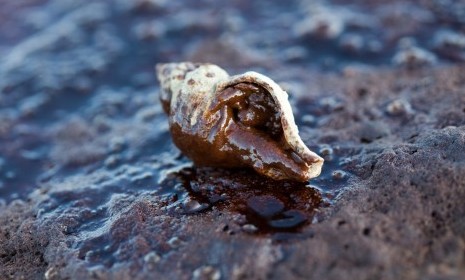BP spill: What happens if the oil gushes until August?
With the "top kill" plan scrapped, there's no quick end in sight to the Gulf oil spill. What happens now?

Now that BP has called off its failed "top kill" operation, company and federal officials say the Gulf of Mexico oil spill won't be stanched until August at the earliest, when BP finishes at least one of two relief wells designed to capture the oil beneath the sea floor and ease pressure on the ruptured well. The Deepwater Horizon spill is already "probably the biggest environmental disaster we have ever faced in this country," according to White House energy adviser Carol Browner. (Watch The Week's Sunday Talk Show Briefing about Obama and the oil spill response.) Here's a concise guide to the next steps:
Why did the "top kill" fail?
Several reasons. First, the well is in worse shape than BP thought, and some of the drilling "mud" that was supposed to plug it got diverted into surrounding rock formations. Second, Energy Secretary Steven Chu decided that continuing the operation ran too high a risk of making the spill worse. University of Texas oil engineering professor Tadeusz W. Patzek says the top kill plan was always a long shot — the equivalent of using two "fire hoses" of drilling mud to counteract "six or seven fire hoses" of oil and gas blasting upwards.
The Week
Escape your echo chamber. Get the facts behind the news, plus analysis from multiple perspectives.

Sign up for The Week's Free Newsletters
From our morning news briefing to a weekly Good News Newsletter, get the best of The Week delivered directly to your inbox.
From our morning news briefing to a weekly Good News Newsletter, get the best of The Week delivered directly to your inbox.
What's BP's next plan?
It's going to try capturing as much of the oil and gas as possible and pipe it to container ships on the surface. In the next four to seven days, BP undersea robots will saw off the bent and toppled riser pipe directly above the four-story-high crippled blowout preventer, which BP says should permit it to install a "snug seal" to a new pipe that will carry "a great majority of the oil" to a drill ship on the surface. (See graphic here.)
What are the chances of success?
Higher than with "top kill," BP says. But even if this containment effort works as planned, some of the oil will still leak into the Gulf.
A free daily email with the biggest news stories of the day – and the best features from TheWeek.com
What are the risks?
BP says cutting the kinked main pipe could increase the oil flow, although not by much. Federal and outside experts, however, warn that the flow could rise by 10 to 20 percent for the week or so it remains uncapped, or longer if the new pipe doesn't collect enough oil and gas. Another danger is that frozen gas hydrates could plug up the new pipe — as they did earlier with contraptions BP had hoped would collect the oil.
What if it fails?
BP is considering trying to fit a new blowout preventer on top of the existing one.
What else is BP doing until August?
Trying to keep the oil from reaching shore, as much as possible. Sen. Mary Landrieu (D-LA) urged BP to immediately commit $1 billion to clean up coastal marshes and wetlands that have already been polluted. BP is also spending millions on promotional campaigns to convince tourists to visit coastal Florida, Mississippi, and Alabama. The federal government is tripling the number of employees and contract workers for the cleanup effort.
How much oil will spill out before August?
Government scientists now estimate that between 12,000 and 19,000 barrels of oil are pouring into the Gulf every day. At that rate, up to 2.3 million gallons will spill out by Aug. 20. The spill is currently on track to be twice as big as the 1989 Exxon Valdez disaster, says BusinessWeek.
How much will this cost BP?
The oil company said Friday it has already spent $930 million on its attempts to stop the leak, in payments to affected states and individuals, and on costs incurred by the federal government. If the spill isn't contained until August, at the current rate, BP will lose about $3 billion, reports the Daily Telegraph, plus any loss of stock value. ING analyst Jason Kenny, however, now estimates that the gusher will cost BP $22 billion if it continues until August.
Will the relief wells really, finally stop the oil?
While BP Managing Director Robert Dudley definitively called them "the end point on this game" on Sunday, not everyone shares his confidence. BP "has been making it up as they go along the whole way," Rep. Ed Markey (D-MA) said Sunday. Well, "this is war," says ING analyst Kenney. "As in all wars, it very rarely goes smooth."
Sources: CNN (2), Washington Post, AP, Reuters, New York Times, Daily Telegraph, LA Times, Bloomberg
-
 Political cartoons for December 6
Political cartoons for December 6Cartoons Saturday’s political cartoons include a pardon for Hernandez, word of the year, and more
-
 Pakistan: Trump’s ‘favourite field marshal’ takes charge
Pakistan: Trump’s ‘favourite field marshal’ takes chargeIn the Spotlight Asim Munir’s control over all three branches of Pakistan’s military gives him ‘sweeping powers’ – and almost unlimited freedom to use them
-
 Codeword: December 6, 2025
Codeword: December 6, 2025The daily codeword puzzle from The Week